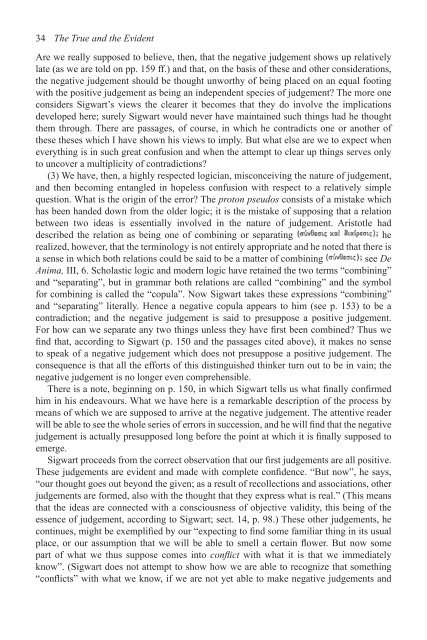Franz Brentano_The True and the Evident.pdf
Franz Brentano_The True and the Evident.pdf
Franz Brentano_The True and the Evident.pdf
Create successful ePaper yourself
Turn your PDF publications into a flip-book with our unique Google optimized e-Paper software.
34<br />
<strong>The</strong> <strong>True</strong> <strong>and</strong> <strong>the</strong> <strong>Evident</strong><br />
Are we really supposed to believe, <strong>the</strong>n, that <strong>the</strong> negative judgement shows up relatively<br />
late (as we are told on pp. 159 ff.) <strong>and</strong> that, on <strong>the</strong> basis of <strong>the</strong>se <strong>and</strong> o<strong>the</strong>r considerations,<br />
<strong>the</strong> negative judgement should be thought unworthy of being placed on an equal footing<br />
with <strong>the</strong> positive judgement as being an independent species of judgement? <strong>The</strong> more one<br />
considers Sigwart’s views <strong>the</strong> clearer it becomes that <strong>the</strong>y do involve <strong>the</strong> implications<br />
developed here; surely Sigwart would never have maintained such things had he thought<br />
<strong>the</strong>m through. <strong>The</strong>re are passages, of course, in which he contradicts one or ano<strong>the</strong>r of<br />
<strong>the</strong>se <strong>the</strong>ses which I have shown his views to imply. But what else are we to expect when<br />
everything is in such great confusion <strong>and</strong> when <strong>the</strong> attempt to clear up things serves only<br />
to uncover a multiplicity of contradictions?<br />
(3) We have, <strong>the</strong>n, a highly respected logician, misconceiving <strong>the</strong> nature of judgement,<br />
<strong>and</strong> <strong>the</strong>n becoming entangled in hopeless confusion with respect to a relatively simple<br />
question. What is <strong>the</strong> origin of <strong>the</strong> error? <strong>The</strong> proton pseudos consists of a mistake which<br />
has been h<strong>and</strong>ed down from <strong>the</strong> older logic; it is <strong>the</strong> mistake of supposing that a relation<br />
between two ideas is essentially involved in <strong>the</strong> nature of judgement. Aristotle had<br />
described <strong>the</strong> relation as being one of combining or separating he<br />
realized, however, that <strong>the</strong> terminology is not entirely appropriate <strong>and</strong> he noted that <strong>the</strong>re is<br />
a sense in which both relations could be said to be a matter of combining see De<br />
Anima, III, 6. Scholastic logic <strong>and</strong> modern logic have retained <strong>the</strong> two terms “combining”<br />
<strong>and</strong> “separating”, but in grammar both relations are called “combining” <strong>and</strong> <strong>the</strong> symbol<br />
for combining is called <strong>the</strong> “copula”. Now Sigwart takes <strong>the</strong>se expressions “combining”<br />
<strong>and</strong> “separating” literally. Hence a negative copula appears to him (see p. 153) to be a<br />
contradiction; <strong>and</strong> <strong>the</strong> negative judgement is said to presuppose a positive judgement.<br />
For how can we separate any two things unless <strong>the</strong>y have first been combined? Thus we<br />
find that, according to Sigwart (p. 150 <strong>and</strong> <strong>the</strong> passages cited above), it makes no sense<br />
to speak of a negative judgement which does not presuppose a positive judgement. <strong>The</strong><br />
consequence is that all <strong>the</strong> efforts of this distinguished thinker turn out to be in vain; <strong>the</strong><br />
negative judgement is no longer even comprehensible.<br />
<strong>The</strong>re is a note, beginning on p. 150, in which Sigwart tells us what finally confirmed<br />
him in his endeavours. What we have here is a remarkable description of <strong>the</strong> process by<br />
means of which we are supposed to arrive at <strong>the</strong> negative judgement. <strong>The</strong> attentive reader<br />
will be able to see <strong>the</strong> whole series of errors in succession, <strong>and</strong> he will find that <strong>the</strong> negative<br />
judgement is actually presupposed long before <strong>the</strong> point at which it is finally supposed to<br />
emerge.<br />
Sigwart proceeds from <strong>the</strong> correct observation that our first judgements are all positive.<br />
<strong>The</strong>se judgements are evident <strong>and</strong> made with complete confidence. “But now”, he says,<br />
“our thought goes out beyond <strong>the</strong> given; as a result of recollections <strong>and</strong> associations, o<strong>the</strong>r<br />
judgements are formed, also with <strong>the</strong> thought that <strong>the</strong>y express what is real.” (This means<br />
that <strong>the</strong> ideas are connected with a consciousness of objective validity, this being of <strong>the</strong><br />
essence of judgement, according to Sigwart; sect. 14, p. 98.) <strong>The</strong>se o<strong>the</strong>r judgements, he<br />
continues, might be exemplified by our “expecting to find some familiar thing in its usual<br />
place, or our assumption that we will be able to smell a certain flower. But now some<br />
part of what we thus suppose comes into conflict with what it is that we immediately<br />
know”. (Sigwart does not attempt to show how we are able to recognize that something<br />
“conflicts” with what we know, if we are not yet able to make negative judgements <strong>and</strong>
















